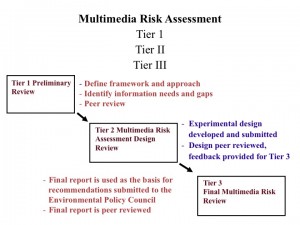Multimedia Risk Assessment for Alternative Fuels
Current Funding: California Air Resources Board, Multimedia Risk Assessment for Alternative Fuels: Guidelines Development, and application to developing alternative fuels in California (co-PI with Thomas McKone, UCB; Dave Rice, ret. LLNL), ~1M$, 2006-2015.
Students Numerous; work was pioneered by doctoral student then postdoctoral associate Tyler Hatch.
Collaborators: Staff from California regulatory agencies CARB, DTSC, EPA, OEHHA, and CWRB.
Project Summary. As required by Section 43830.8 California Health and Safety Code, before adopting new fuel specifications, the California Air Resources Board (CARB) must provide a “multimedia assessment” of these new fuels. Under this project the California Air Resources Board with input from the co-PIs and Collaborators listed has prepared guidelines (MMAG_FINAL.pdf) for “multimedia” evaluations of new fuels entitled “Guidance Document and Recommendations on the Types of Scientific Information to be submitted by Applicants for California Fuels Environmental Multimedia Evaluations.” This document was prepared to assist the California EPA’s Multimedia Working Group (MMWG) in making decisions about new fuel specifications.
Tiered Assessement strategy forming the basis for our approach.
We are currently or recently involved in application of the multimedia evaluation that we designed, to Biodiesel, Renewable Diesel, E85, Natural Gasoline Liquids, DiMethyl Ether (DME), Compressed Natural Gas, and ongoing fuels development. Sometimes as in the case of DME we work with fuel proponents (Oberon, Inc.) and in some instances we represent the State during respecification of a fuel (compressed natural gas). For example, our group provided the technical support for formal multimedia risk assessment for biodiesel, renewable diesel, and E-85 in California. Biodiesel is the name of an alternative diesel-equivalent fuel, derived from biological sources (such as vegetable oils), which can be used in unmodified diesel-engine vehicles. Biodiesel is made through a chemical process called transesterification whereby the glycerin is separated from the fat or vegetable oil. The process generates methyl esters (the chemical name for biodiesel) and glycerin as well as other byproducts (washwater, water, free fatty acids) and residual reactants (e.g., methanol). The multimedia risk assessment involves a three-tiered strategy for prioritizing and estimating impacts of import, production, transport, use, and storage of the materials involved in manufacture, distribution and use of this fuel in the state. Biodiesel rulemaking incorporated the results of our analyses.
Important Publications on this Topic:
- Ginn, T. R., T. McKone, and D. Rice, California Renewable Diesel Multimedia Evaluation Tier III Final Report: 2013. http://www.arb.ca.gov/fuels/multimedia/meetings/meetings.htm.
- McKone, T., T. R. Ginn, and D. Rice, California Biodiesel Multimedia Evaluation Tier III Final Report: Biodiesel, 2013. http://www.arb.ca.gov/fuels/multimedia/meetings/meetings.htm.
- Ginn, T. R., T. McKone, and D. Rice, California E85 Multimedia Evaluation Final Tier I Report, 2012. (rulemaking postponed, no posting as of 10/2014).
- Ginn, T. R., T. Hatch, J. Miller, K. M. Scow, A. Epple, M. B. Johnson, L. Rastagarzadeh, T. Schetrit, T. H. Barkouki, and V. Nino, California Biodiesel Multimedia Evaluation Final Tier I Report, 2010 http://www.arb.ca.gov/fuels/multimedia/meetings/meetings.htm.
- Rice, D., T. McKone, and T. R. Ginn, California Renewable Diesel Multimedia Evaluation Tier I Final Report, 2010 http://www.arb.ca.gov/fuels/multimedia/meetings/meetings.htm.
- Ginn, T. R., T. McKone, and D. Rice, Guidance Document and Recommendations on the Types of Scientific Information to be Submitted by Applicants for California Fuels Environmental Multimedia Evaluations Prepared for the Multimedia Working Group by UC Berkeley, UC Davis, and Lawrence Livermore National Laboratory, UCRL-AR-219766, 2008. http://www.arb.ca.gov/fuels/multimedia/guidancedoc.pdf.






